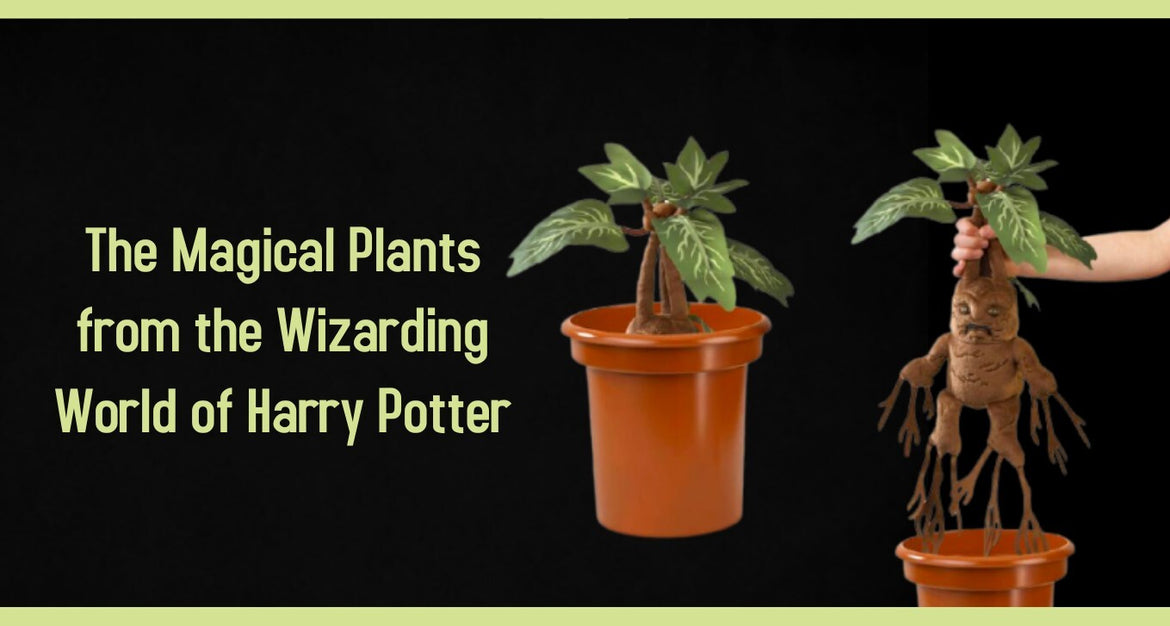What Are Some Iconic Magical Plants In Harry Potter?
If you’ve ever delved into the enchanting world of Harry Potter, you know that it is filled with all sorts of magical wonders. From flying broomsticks to talking portraits, every aspect of the wizarding world is brimming with captivating elements. One such aspect that adds a touch of whimsy and fascination to the narrative is the presence of magical plants. In this article, we will explore some of the most iconic and awe-inspiring magical plants in the Harry Potter series.
When it comes to the flora of the wizarding world, J.K. Rowling’s imagination knows no bounds. From the venomous Devil’s Snare to the mischievous Mimbulus Mimbletonia, there is no shortage of peculiar and captivating plants that play a significant role in the wizarding adventures. These magical plants not only showcase Rowling’s creativity but also serve as crucial plot devices, adding depth and intrigue to the story. So, grab your wand and get ready to dive into the world of magical botany as we explore some of the most iconic plants that have captured the hearts of Harry Potter fans around the globe.
Harry Potter is filled with iconic magical plants that captivate readers and viewers alike. One such plant is the Mandrake, known for its restorative properties and distinctive cry. The Whomping Willow is another famous plant, guarding the entrance to Hogwarts with its violent branches. The Devil’s Snare, a dangerous vine that strangles its victims, is also well-known. And who can forget the venomous Tentacula and its snapping jaws? These plants add depth and intrigue to the magical world of Harry Potter.

Iconic Magical Plants in Harry Potter
In the wizarding world of Harry Potter, plants play a significant role in adding depth and intrigue to the magical realm. From the venomous Whomping Willow to the whimsical Mandrake, these plants captivate readers and viewers alike. In this article, we will explore some of the most iconic magical plants in the Harry Potter series, their characteristics, and their importance to the wizarding world.
The Whomping Willow
The Whomping Willow is one of the most notorious and dangerous magical plants in the Harry Potter universe. This sentient tree, with its long, winding branches, acts as the guardian of the entrance to the secret passage leading to the Shrieking Shack. It is known for its violent nature, thrashing its branches and attacking anything that comes near it. The Whomping Willow adds an element of danger and excitement to the story, providing an obstacle for Harry, Ron, and Hermione as they navigate their way through Hogwarts.
Interestingly, the Whomping Willow is also a key part of the backstory of Professor Remus Lupin, who was a werewolf. During his time at Hogwarts, Lupin would retreat to the Shrieking Shack through the passage under the Whomping Willow every full moon to transform into a werewolf in isolation. This connection between Lupin, the Whomping Willow, and the Shrieking Shack adds depth to the characters and the magical world they inhabit.
Characteristics of the Whomping Willow
The Whomping Willow is a massive tree with gnarled branches and a thick, knotted trunk. Its branches are covered in sharp spikes, and it has a strong propensity for violence. When someone or something approaches it, the Whomping Willow will thrash its branches, attempting to harm or repel the intruder. It is also enchanted to be resistant to most forms of magic, making it a formidable obstacle to overcome.
Despite its dangerous nature, the Whomping Willow does have a softer side. In the third book, “Harry Potter and the Prisoner of Azkaban,” it is revealed that the tree forms a bond with the hippogriff Buckbeak. Buckbeak, a magical creature resembling a half-eagle and half-horse, is able to approach the Whomping Willow without triggering its violent response. This unexpected friendship adds a touch of heart to the story and showcases the complexity of the magical world.
The Mandrake
The Mandrake, also known as Mandragora, is a magical plant that features prominently in the second book of the Harry Potter series, “Harry Potter and the Chamber of Secrets.” These plants have a humanoid form, with roots resembling limbs and a tuft of leaves on top resembling a head. The Mandrake’s cry is fatal to anyone who hears it, making it a dangerous plant to handle.
In the story, Professor Sprout teaches her Herbology students about the properties and uses of Mandrakes. The students are tasked with wearing earmuffs to protect themselves from the Mandrake’s cry while repotting them. The restorative properties of the Mandrake are later used to save the petrified students who have been attacked by the basilisk, a giant serpent controlled by the heir of Slytherin.
Characteristics of the Mandrake
Mandrakes are known for their potent restorative properties. When properly prepared, their cry can be used to revive those who have been petrified or put into a deep sleep. However, the cry of a mature Mandrake is fatal to anyone who hears it, which is why it is crucial to wear earmuffs when handling them.
In addition to their medicinal uses, Mandrakes also have a rich folklore surrounding them. In mythology, it was believed that Mandrakes had magical and aphrodisiac properties. They were often associated with fertility and used in various rituals and potions. J.K. Rowling’s incorporation of this folklore into the Harry Potter series adds depth and a sense of history to the magical world.
The Devil’s Snare
The Devil’s Snare is a magical plant introduced in the first book, “Harry Potter and the Philosopher’s Stone.” It serves as one of the obstacles guarding the Philosopher’s Stone, alongside the challenges set up by the wise and mysterious Professor Dumbledore. The Devil’s Snare is a dangerous plant that thrives in dark, damp environments.
When Harry, Ron, and Hermione encounter the Devil’s Snare while attempting to reach the Philosopher’s Stone, they quickly realize that struggling and fighting only makes the plant tighten its grip. Hermione, using her knowledge of Herbology, remembers that Devil’s Snare dislikes light and heat. They manage to escape by using the spell “Lumos Solem” to create a burst of sunlight, causing the plant to retreat.
Characteristics of the Devil’s Snare
The Devil’s Snare is a plant with long, creeping vines that possess a strong grip. It has a tendency to wrap itself tightly around anything that comes into contact with it, suffocating and constricting its victims. The plant’s strength lies in its ability to sense and exploit fear and panic. The more its prey struggles, the tighter it constricts.
Despite its dangerous nature, the Devil’s Snare can be overcome with the right knowledge and approach. Light and warmth are its weakness, as it thrives in darkness and cold. By using the spell “Lumos Solem” to create sunlight, the trio effectively neutralizes the plant’s threat and continues their quest.
Other Iconic Magical Plants
The Whomping Willow: A Guardian and a Remnant of the Past
Besides its role in guarding the secret passage to the Shrieking Shack, the Whomping Willow holds a deeper significance within the Harry Potter series. It serves as a physical representation of the past, particularly for Professor Remus Lupin. As a werewolf, Lupin found solace and safety within the confines of the Shrieking Shack, accessed through the Whomping Willow. This connection adds a layer of complexity and emotion to both the character and the plant.
The Whomping Willow’s violent nature adds tension and excitement to the story, keeping readers on the edge of their seats. Its ability to withstand most forms of magic showcases the power and resilience of certain magical plants in the wizarding world.
The Venomous Tentacula: A Carnivorous Plant
The Venomous Tentacula is a dangerous, carnivorous plant that appears in the Harry Potter series. It has thick, spiky vines and a gaping mouth filled with sharp teeth. This plant is known for its ability to ensnare and devour small animals and even humans.
In “Harry Potter and the Goblet of Fire,” the Venomous Tentacula is featured in the Herbology lesson taught by Professor Sprout. Students are warned to exercise caution when handling it due to its aggressive nature. The Venomous Tentacula adds an element of danger and suspense to the magical world, reminding readers of the potential hazards that exist within nature.
The Gillyweed: An Aid for Underwater Exploration
The Gillyweed is a magical plant that allows the user to breathe underwater and move freely in aquatic environments. It plays a crucial role in “Harry Potter and the Goblet of Fire” during the Triwizard Tournament’s second task, where participants must retrieve something valuable from the bottom of a lake.
The Gillyweed is ingested by the characters to grant them the ability to survive and navigate underwater. This plant exemplifies the usefulness and versatility of magical plants, providing characters with the means to overcome challenges and achieve their goals.
Conclusion
The world of Harry Potter is filled with iconic magical plants that add depth, excitement, and intrigue to the story. From the dangerous Whomping Willow to the medicinal Mandrake, these plants capture the imagination and bring the wizarding world to life. Their unique characteristics and roles within the narrative create a rich and immersive experience for readers and viewers alike. Whether they serve as guardians, obstacles, or aids, these magical plants contribute to the enchantment and wonder of the Harry Potter series.
Key Takeaways: What are some iconic magical plants in Harry Potter?
– Devil’s Snare, a dangerous plant, has the ability to constrict and suffocate its victims.
– Venomous Tentacula, a carnivorous plant, can attack and trap its prey.
– Gillyweed, when consumed, allows individuals to breathe underwater and swim like fish.
– The Whomping Willow, a magical tree, is known for its violent branches and ability to attack anyone who comes near.
Frequently Asked Questions
In the magical world of Harry Potter, there are numerous iconic plants that play significant roles in the story. From the venomous Devil’s Snare to the mysterious Mandrakes, these plants add a touch of magic and danger to the wizarding world. Here are some frequently asked questions about the iconic magical plants in Harry Potter.
1. What is the significance of Devil’s Snare in Harry Potter?
Devil’s Snare is a magical plant known for its ability to ensnare and suffocate anything that comes into contact with it. In Harry Potter, Devil’s Snare plays a crucial role in the first book, “Harry Potter and the Philosopher’s Stone.” It serves as an obstacle that the trio (Harry, Ron, and Hermione) must overcome to reach the Philosopher’s Stone. The plant’s weakness to light and fire is revealed, emphasizing the importance of thinking quickly and finding creative solutions.
Devil’s Snare also symbolizes the theme of facing fears and reliance on teamwork. Hermione’s knowledge of the plant and Harry and Ron’s cooperation ultimately lead to their escape. It serves as a reminder that sometimes the most dangerous challenges can be overcome by using one’s wits and working together.
2. What are the characteristics of Mandrakes in Harry Potter?
Mandrakes are magical plants with a humanoid appearance. They have long, root-like bodies and a high-pitched cry that can be fatal to anyone who hears it. In the Harry Potter series, Mandrakes are known for their healing properties. Their restorative properties are particularly useful in treating petrification caused by the Basilisk’s gaze.
Mandrakes are depicted as being highly valuable and dangerous. They require careful handling, as their cry can render a person unconscious or even kill them. The process of harvesting Mandrakes includes wearing earmuffs to protect against their cries. Overall, Mandrakes add an element of danger and intrigue to the magical world of Harry Potter.
3. What role does the Whomping Willow play in the Harry Potter series?
The Whomping Willow is a magical tree with a violent temperament. It plays a significant role in the Harry Potter series, particularly in “Harry Potter and the Chamber of Secrets” and “Harry Potter and the Prisoner of Azkaban.” The tree’s branches and roots move aggressively, making it a formidable obstacle.
In “Harry Potter and the Chamber of Secrets,” the Whomping Willow guards the entrance to the secret passage that leads to the Chamber of Secrets. In “Harry Potter and the Prisoner of Azkaban,” it is revealed that the Whomping Willow was planted to conceal the entrance to the Shrieking Shack, where Remus Lupin transforms into a werewolf. The tree’s aggressive nature adds tension and suspense to the story, highlighting the dangerous world that Harry and his friends navigate.
4. What are some properties of the Venomous Tentacula in Harry Potter?
The Venomous Tentacula is a magical plant known for its aggressive nature and venomous properties. Its long, spiky tentacles have a tendency to attack anyone who comes too close. In the Harry Potter series, the Venomous Tentacula is often depicted as a dangerous plant that poses a threat to those who encounter it.
While the Venomous Tentacula is not central to the main plot, it adds an element of danger and excitement to the wizarding world. Its inclusion in various scenes serves as a reminder of the magical world’s inherent risks and the need for caution.
5. What is the role of the Mandrake Root in potion-making?
The Mandrake Root plays a crucial role in potion-making in the Harry Potter series. Its restorative properties make it a key ingredient in the brewing of the Mandrake Restorative Draught, a potion used to revive petrified individuals. The Mandrake Root is known for its ability to cure ailments and reverse the effects of certain magical spells.
In “Harry Potter and the Chamber of Secrets,” the Mandrake Restorative Draught is used to save the petrified students at Hogwarts. The process of brewing the potion involves extracting the cry of the Mandrake and combining it with other ingredients. The Mandrake Root’s significance in potion-making showcases the intricate nature of magical remedies and the importance of herbology in the wizarding world.
The Magic Plants of Harry Potter
Final Summary: The Enchanting World of Harry Potter’s Iconic Magical Plants
As we journey through the magical world of Harry Potter, we are captivated by the wonders and enchantments that await us at every turn. Among the many captivating elements of this beloved series are the iconic magical plants that add an extra touch of whimsy and intrigue to the wizarding world. From the mischievous Mandrakes to the powerful Whomping Willow, these plants have become an integral part of the Harry Potter universe.
One of the most iconic magical plants in Harry Potter is the Mandrake. These peculiar plants have humanoid roots and possess powerful restorative properties. Their cries can be fatal to those who hear them, but their healing powers make them a vital ingredient in potions and antidotes. Another notable plant is the Venomous Tentacula, a dangerous plant with writhing, venomous vines that can ensnare unsuspecting victims. It serves as a reminder that not all plants in the wizarding world are friendly.
The Whomping Willow is another unforgettable magical plant in the Harry Potter series. This massive tree, with its violent branches and a propensity for attacking anything that comes near it, guards the entrance to the secret passage leading to the Shrieking Shack. Its presence adds an air of mystery and danger to the grounds of Hogwarts School of Witchcraft and Wizardry.
The magical plants in Harry Potter are not just fantastical creations; they play significant





